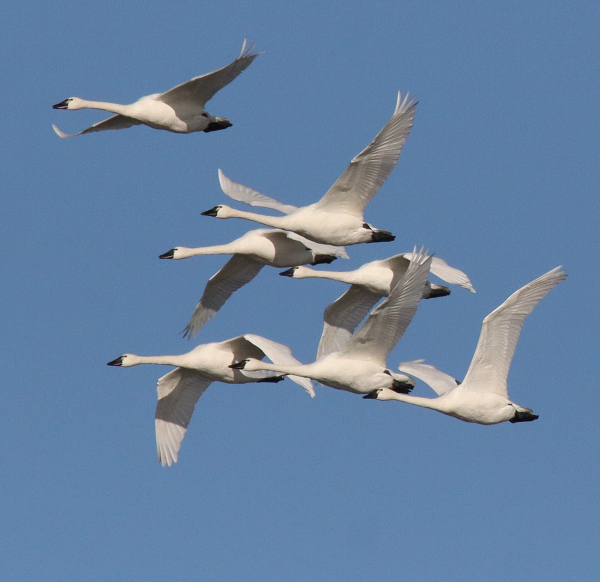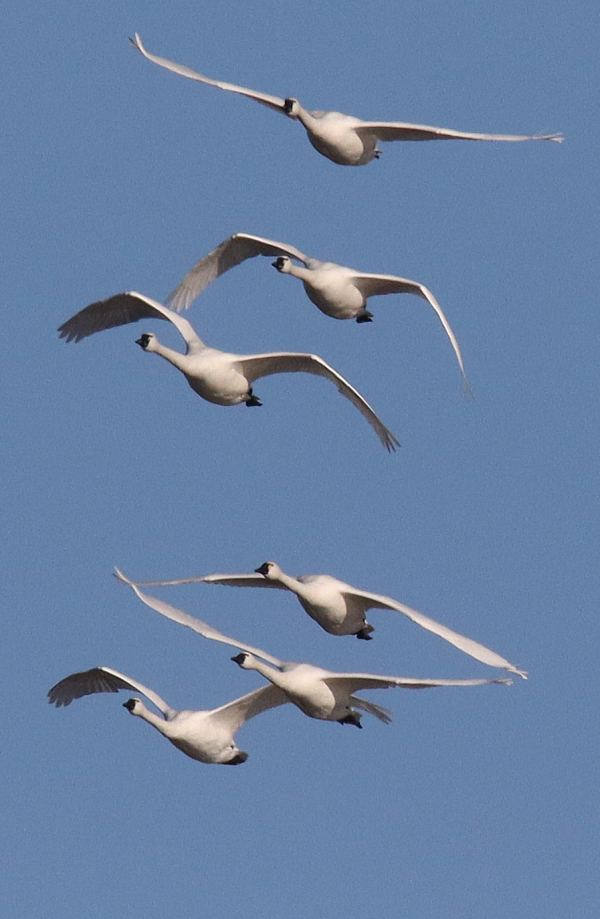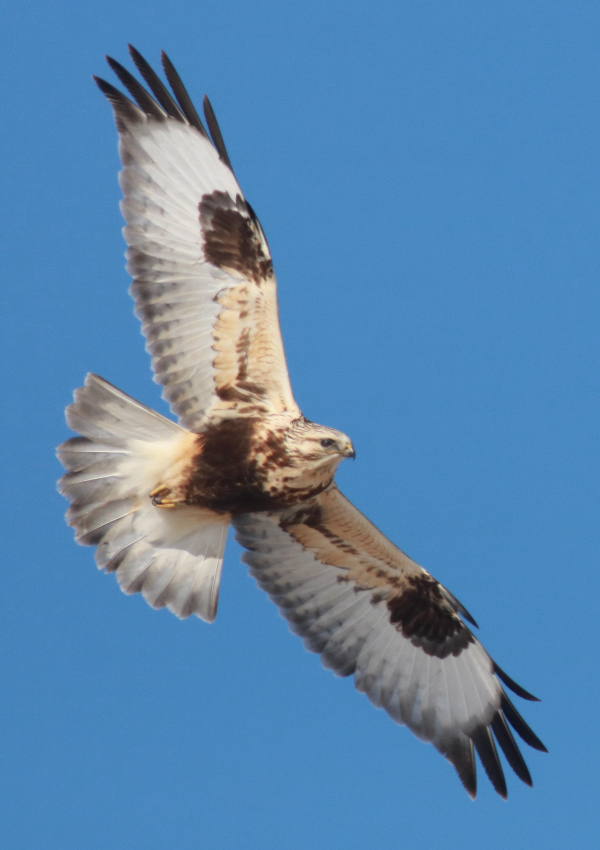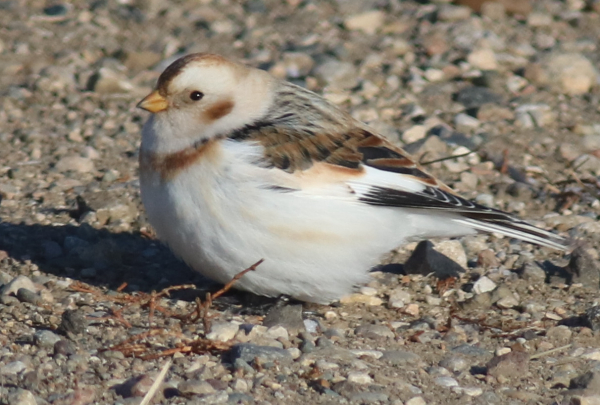
Providing some of the most exciting moments of late fall, the advance of 7 Tundra Swans leading a flock of 20 provided an unusual formation as they turned broadside to the afternoon sun.

The same group of Tundra Swans turned to fly into the sunlight during their advancing flight. There were about 50 swans in the group, made up of 2 larger flocks and followed by pairs and family groups.

Almost daily sightings of Rough-legged Hawks are especially welcome.

Although flocks of Snow Buntings are very widely scattered and probably on the move, it’s exciting to see them as part of the mix of birds that have migrated from the Arctic to the northern plains.
|
We all relish exploring new areas, and having explored far corners of the planet in search of exciting birds, an explorer’s memory kicked in as I topped a hill that revealed a broad, untouched prairie landscape the filled my view to a distant ridge where it merged with clear blue sky. During a Saturday swan expedition I delighted in exploring the area surrounding a huge lake, only 30 miles away but very remote and wild. I was looking for a way to access the expansive lake where there were well over 400 Tundra Swans, plus all the ducks and geese that prefer the same large lakes.
As usual, the swans tended to be white spots in the distance, but this time I was looking for a place where I could photograph flying swans, perhaps as they were winging to a nearby location. The lake was about 3 miles long, filling a broad irregularly shaped basin, and access to the other side of the lake appeared to be quite limited. I could see a couple ranches in the distance, so there must be a road somewhere over that way. I followed a remote road that angled south of the lake, then curved north to parallel the east side of the lake – just what I was looking for.
As I topped a high hill I could see the huge swan lake to my left, with a small half-frozen lake to my right – and the open area of the smaller, closer lake was filled with Tundra Swans – a nice surprise for this Saturday explorer. After glassing the swans with my binoculars while soaking in the moody swans sounds, I took a few photos of parts of the concentration of swans while wondering how I might get closer, but just then my concentration was broken by a swan call to my left.
Turning revealed 5 Tundra Swans flying in my direction, presumably headed to join the swans to my right. Waiting for the swans to approach closer, the sun was conveniently at my back as the swans flew above and in front of me as they winged from the huge lake to the small one. Indeed, this could be the answer to my search for a location to photograph the swans in flight. Some swans did fly closer, some not so close, but that’s part of the action, and part of the excitement, but I must admit the flocks were pretty few and far between.
As I waited, I had a chance to get a pretty good count of the swans in the small lake – about 160. That surprised me and I had to rethink the idea that there were 400 swans in the huge lake – there could easily be more than 500. During another wait period I sighted a distant adult Bald Eagle chase a lone Snow Goose, although the goose quickly out-distanced the eagle. I also watched a circling Rough-legged Hawk nearby while still enjoying the background swan songs. On my way home, I sighted 2 Merlins, one flying, and one perched – both male Taiga Merlins. That made 3 Merlins sighted in 2 days – a good sign for seeing more Merlins during the warming temperatures during the next week.
I also felt lucky to find an area with a few small flocks of feeding White-fronted Geese, and a flock of Cackling Geese that flew over the area too. Not far away a small flock of about 70 Canada Geese was feeding, and these flocks stood out from the remarkable abundance of Snow Geese in the region: 9 flocks of more than 1,000 Snows with Ross’s Geese mixed among them. It’s quite a thrill to see this kind of a concentration of waterfowl, and any time I step outside my house I can hear goose music, and can usually see flocks of Snow Geese flying low too. The longer they stay in the area, the better, and with warmer weather on the agenda, their date of exodus is beyond the reach of local weather predictions.
Sunday Rerun
With the temperature 20 degrees warmer (55F) and a 20mph wind I wanted to return to see if the Tundra Swans might be closer to the road after the ice on the small lake cleared with the warmer weather, and if swans were still positioned at the far side of the lake where I photographed Saturday. Although there were only about 35 swans on the far end of the small lake, there were 30 more in a side bay, but it was quickly apparent that fewer swans were flying between the 2 lakes, but with a pair flying here and a family group there my interest was wetted.
Little did I know or expect what I saw next: 2 big flocks of about 20 swans each flying in formation behind one another, plus some smaller groups of 2 to 5 following, and they were headed in my direction – woo-wee! The swans approached in full sunlight, showing bright white against the clear blue sky, and the ensuing seconds when they could have turned to one side or the other felt a bit dramatic. As the first flock approached I concentrated on one group on the left side that flew in a tight group including 7 graceful swans, and was duly rewarded with the best photos of my hour-long visit; actually the best photos of the week. As that group passed, more and more swans approached, turning into the sun in the best possible way. It was so fun to experience this flight of swans, and how I’d like to relive that photo episode again and again!
With the strong wind, there was little action aside from waterfowl Sunday, but I did see a flock of about 20 Snow Buntings, a female Northern Harrier, and a female Rough-legged Hawk on the hunt that even tried hovering into the strong west wind.
Closer to Home
Spotty sunlight Monday kept me closer to home, which was appropriate considering I hadn’t checked on some of my regular wetlands yet this week. First I checked the long lake a mile north of my office, where I found a huge flock of Snow Geese feeding in a harvested cornfield within a few yards of the water. Just south of my office a mixed flock of about 120 Cackling and Canada Geese with 4 White-fronted Geese almost indistinguishable in their midst was resting in shallow water offshore of Melody’s Marsh, although when I returned an hour later they were feeding in an adjacent field.
Two miles south of my workplace, a huge flock of Snow Geese covered hundreds of acres of harvested corn, and 4 miles south an even larger flock of thousands of Snows was feeding. Each of these 3 big Snow Goose concentrations had a small percentage of Ross’s Geese mixed in, although they were hard to pick out among the many geese in flight and on the ground. Three miles farther south I sighted a resting flock of Canada and Cackling Geese numbering about 40 with a surprise pair of Tundra Swans and a few Mallards.
There were 2 more Tundra Swans on the far side of Charo Marsh, plus about 50 Canada Geese at my friend Herb’s lake, along with a big flock of Lesser Scaup. On the other side of the road, 7 Tundra Swans including 5 young swans were at the far end of the lake. Over the next hill, the aptly named Swan Marsh held 38 Tundra Swans, almost all in adult plumage in the company of a few Mallards.
Along that favorite local route I expected the geese from recent experience, but I was especially happy to see the Tundra Swans in the area. It just goes to show that you gotta get out there to see what surprises await. Looking at the long-term weather forecasts, it looks like the lakes will remain ice-free through Thanksgiving, which is a much-appreciated extension to what could have been an especially early freeze-up 2 weeks ago. Now, the cold-weather waterfowl may persist into December; but wait, let’s not jinx it. Instead, I’ll enjoy every sunny day with temperatures above freezing – it’s that time of the year. Enjoy your birding opportunities during the next week – have you seen any Wild Turkeys lately?
Article and photos by Paul Konrad
Share your bird sightings and photographs at editorstbw2@gmail.com